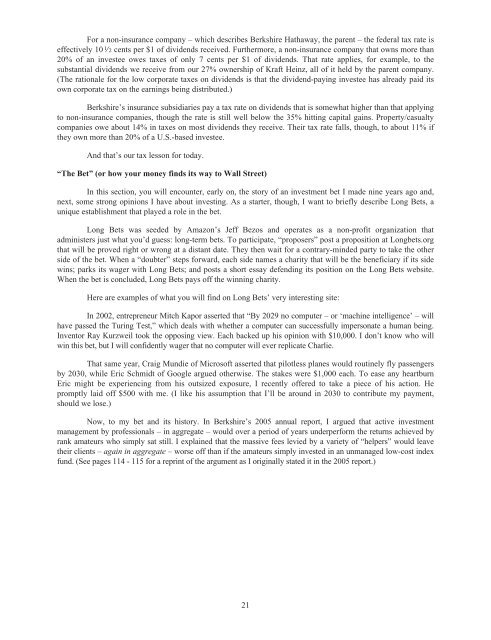Berkshire’s Performance vs the S&P 500 2
gnjtA93
gnjtA93
You also want an ePaper? Increase the reach of your titles
YUMPU automatically turns print PDFs into web optimized ePapers that Google loves.
For a non-insurance company – which describes Berkshire Hathaway, <strong>the</strong> parent – <strong>the</strong> federal tax rate is<br />
effectively 10 1 ⁄2 cents per $1 of dividends received. Fur<strong>the</strong>rmore, a non-insurance company that owns more than<br />
20% of an investee owes taxes of only 7 cents per $1 of dividends. That rate applies, for example, to <strong>the</strong><br />
substantial dividends we receive from our 27% ownership of Kraft Heinz, all of it held by <strong>the</strong> parent company.<br />
(The rationale for <strong>the</strong> low corporate taxes on dividends is that <strong>the</strong> dividend-paying investee has already paid its<br />
own corporate tax on <strong>the</strong> earnings being distributed.)<br />
<strong>Berkshire’s</strong> insurance subsidiaries pay a tax rate on dividends that is somewhat higher than that applying<br />
to non-insurance companies, though <strong>the</strong> rate is still well below <strong>the</strong> 35% hitting capital gains. Property/casualty<br />
companies owe about 14% in taxes on most dividends <strong>the</strong>y receive. Their tax rate falls, though, to about 11% if<br />
<strong>the</strong>y own more than 20% of a U.S.-based investee.<br />
And that’s our tax lesson for today.<br />
“The Bet” (or how your money finds its way to Wall Street)<br />
In this section, you will encounter, early on, <strong>the</strong> story of an investment bet I made nine years ago and,<br />
next, some strong opinions I have about investing. As a starter, though, I want to briefly describe Long Bets, a<br />
unique establishment that played a role in <strong>the</strong> bet.<br />
Long Bets was seeded by Amazon’s Jeff Bezos and operates as a non-profit organization that<br />
administers just what you’d guess: long-term bets. To participate, “proposers” post a proposition at Longbets.org<br />
that will be proved right or wrong at a distant date. They <strong>the</strong>n wait for a contrary-minded party to take <strong>the</strong> o<strong>the</strong>r<br />
side of <strong>the</strong> bet. When a “doubter” steps forward, each side names a charity that will be <strong>the</strong> beneficiary if its side<br />
wins; parks its wager with Long Bets; and posts a short essay defending its position on <strong>the</strong> Long Bets website.<br />
When <strong>the</strong> bet is concluded, Long Bets pays off <strong>the</strong> winning charity.<br />
Here are examples of what you will find on Long Bets’ very interesting site:<br />
In 2002, entrepreneur Mitch Kapor asserted that “By 2029 no computer – or ‘machine intelligence’ – will<br />
have passed <strong>the</strong> Turing Test,” which deals with whe<strong>the</strong>r a computer can successfully impersonate a human being.<br />
Inventor Ray Kurzweil took <strong>the</strong> opposing view. Each backed up his opinion with $10,000. I don’t know who will<br />
win this bet, but I will confidently wager that no computer will ever replicate Charlie.<br />
That same year, Craig Mundie of Microsoft asserted that pilotless planes would routinely fly passengers<br />
by 2030, while Eric Schmidt of Google argued o<strong>the</strong>rwise. The stakes were $1,000 each. To ease any heartburn<br />
Eric might be experiencing from his outsized exposure, I recently offered to take a piece of his action. He<br />
promptly laid off $<strong>500</strong> with me. (I like his assumption that I’ll be around in 2030 to contribute my payment,<br />
should we lose.)<br />
Now, to my bet and its history. In <strong>Berkshire’s</strong> 2005 annual report, I argued that active investment<br />
management by professionals – in aggregate – would over a period of years underperform <strong>the</strong> returns achieved by<br />
rank amateurs who simply sat still. I explained that <strong>the</strong> massive fees levied by a variety of “helpers” would leave<br />
<strong>the</strong>ir clients – again in aggregate – worse off than if <strong>the</strong> amateurs simply invested in an unmanaged low-cost index<br />
fund. (See pages 114 - 115 for a reprint of <strong>the</strong> argument as I originally stated it in <strong>the</strong> 2005 report.)<br />
21


